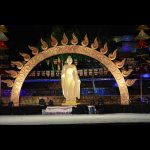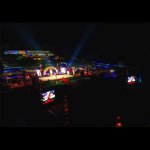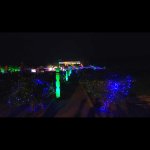
Dazzling show at Buddhist monument
- Jyothi Raghuram
e-mail: jyothi.r.ram@gmail.com
December 25, 2016
This was one show unparalleled in its beautifully lit fairytale setting
and pulsating folk dances. The venue was beyond of nowhere—a remote
Buddhist monument near a nondescript village, Anupu, on the Andhra
Pradesh-Telangana border; inaccessible to both the public and artistes.
One has attended several festivals held against the backdrop of
ancient temples and monuments across India; rarely has one been
transported to a magical land where spectacular lighting created a
stunning backdrop for a music and dance festival that echoed as much in
one’s memory as it did in one’s ears.
The Infosys Foundation Anupu Festival 2016 (Dec 9 – 11,
2016) at that far away place seemed more of a mad misadventure when one
heard of it. Imagine holding a three-day art festival at a venue where
even a drop of water is unavailable, and far-removed from civilization.
Anupu is a good three hours’ drive from Hyderabad, its closest city. But
it was literally in the lap of a proud civilizational history that
Anupu celebrated its past, revisiting a glory that was once its lot.
The Anupu festival, ambitious in variety, was a mix of classical dance
and music, folk dances, dance dramas and even a fine arts camp. Artistes
are eager adventurists; stage outings don’t come easy. It is the
audience turnout that matters, wherever or whatever the show. Else, any
event is a dud. With the efforts expended and money spent, the monument
could gain in footfalls. The question was: who would come to the show,
given its location.
Perhaps the most gratifying aspect of the festival was that artistes
performed to an overflowing and appreciative audience, the 2500 seating
capacity filled to brim. The purpose of the festival had been met with
this response alone. Folk from nearby villages, perhaps impelled by
curiosity, came in large numbers on the inaugural day. The crowd swelled
progressively, school and college goers, comprising a major chunk,
adding liveliness to the festival; distant Anupu bringing to youth some
of the best of traditional performing arts was an
achievement in itself.
Folk dances, by definition, are celebratory, their robustness
complementing their raw appeal. Stylised classical forms such as
Kuchipudi and Bharatanatyam provided the necessary contrast and variety
at the event, integral to which was the vibrant, authentic, and
colourful dance and fashion show of the employees of Infosys, Hyderabad,
contemporary in the beat of its music but completely ethnic in content.
The pure rhythm background score for the ethnic fashion show,
displaying the costumes of India, had a huge popular appeal, expectedly
drawing audience response.
View slideshow
The festival, drawing only from arts and artistes of the Telugu region,
was appreciable for its encouragement of local forms and talent. At
least nine different folk and tribal dances being presented was a clear
attempt to protect an ethnicity that is gradually
disappearing from villages and Lambadi tandas, as youngsters move to
cities; an exodus that will wipe out a significant part of the real
identity of India.
Certainly the toast of the three-day cultural outing was Oggukatha, the
spirited dance of the young, all-male troupe worthy of a standing
ovation. Presented by Oggudolu Vinyasam troupe, the Oggukatha made for a
meaningful study of how folk dances can be contoured to suit modern
audience tastes and easily overtake its urban counterparts.
Experimentation and innovation in its music, movements, rhythm and
costuming were the hallmarks of the show, their vigour and enthusiasm
infusing zest even among the audience. Oggukatha finds its origin among
the Yadavas or shepherds. The dance, centred round the deities Yellamma
and Mallikarjuna, is replete with ritualistic features, its religious
and spiritual nucleus visible in the passionate involvement of the
dancers. The full-toned, distinct slaps and tones of the dollu, jaggu
(damaruka) and taalam, and the agile and gravity-defying acrobatics of
the 15 sprightly dancers reached out to the audience in a primordial
way, the rhythm and movement completing a cycle of ritualistic
dramatization.
The Oggudolu Vinyasam dancers are no doubt devoted to the art form which
is a way of worship to them, even while they continue to lead a
pastoral life in villages. Yet what is of deep concern is that unless an
art has a commercial angle in terms of earnings, it dies a natural
death. All folk and tribal arts thus face extinction.
Ravi Kumar Chowdarapally, who is doing his PhD in folk dance, is
training youth in Oggukatha in different parts of Telangana with a
missionary zeal. Yet he admits that “financially it is very difficult
for the dancers to survive because the dance is traditional and not
commercial.” Oggukatha has the potential of establishing itself as one
of the world’s premiere performing art if it is patronized and given due
exposure, he says. The Oggudolu Vinyasam recital certainly vouched for
this.
Tappeta Gullu, Garagalu, Bonalu, Gussadi, Veera Natyam, Dappu, Mathuri
and Lambadi were the other earthy forms presented, giving a glimpse of
the rich folk and tribal performing arts traditions of the Telugu
region. Deepa Tarangini, the signature dance number of Sri Rama Nataka
Niketan, Secunderabad, was high on popularity, brightly painted earthen
pots and lit candles being the main props of the agile dancers. The
other dances that followed were mundane in conception and denouement,
the overtly lokadharmi portrayal rendering them inane.
Bhama Kalapam, synonymous with Siddhendra Yogi, projects the many facets
of the charming yet haughty Satyabhama. Vedantam Radheshyam donning
the role brought back to memory how easily he could
transform into the ultra-feminine, coy Satyabhama, vestiges of which
were still visible.
Another noteworthy concert was that of vainika D. Srinivas whose
intelligent choice of crisp, racy compositions was apt for the audience
profile. Komanduri Venkata Krishna (violin), Parupalli Ramakrishnaiah
Pantulu (mridangam) and R. Srikanth (khanjira) were equal contributors
to the racy outing.
A special word about the Infosys Hyderabad artistes; proving to be as
adept on stage, the Infosys team put up a professional show, be it in
costuming, music or the dance, blurring the line between trained
artistes and amateurs. Their outing was certainly one of the highlights
of the festival.
Anupu valley is a re-located Buddhist archaeological site dating back to
the 3rd century, on the banks of the Krishna River near Nagarjunasagar
dam. Its large amphitheatre with the graded columns is the central
attraction, its picturesque setting enhanced by golden hues at dawn and
sunset, against the backdrop of the Nagarjuna hills.



Lighting by Srinivasa Prabhath of Prabhath Sound System shone in
brilliance, both in its aesthetics and contouring of the graded backdrop
of the monument. Sparkling lights twinkled like gems all around the
venue, right from the far flung entrance, transforming the environs into
a rainbow-hued fantasyland. The dazzling work of Prabhath was
undoubtedly a major contributor to the success of the festival.
The art camp, themed Landscapes of Anupu, saw the
participation of some 16 artists, picked up from the Jawaharlal National
Architecture and Fine Arts University, Hyderabad. Bharatiya Vidya
Bhavan, Bengaluru Kendra, supported the event.
Jyothi Raghuram is an art critic and freelance writer based in Bangalore.
|





